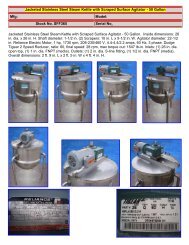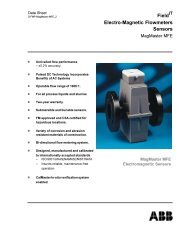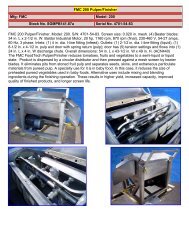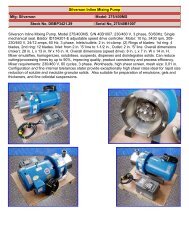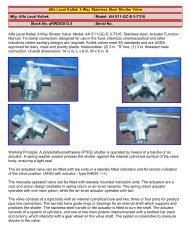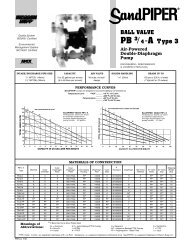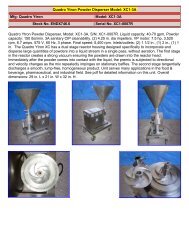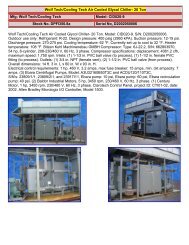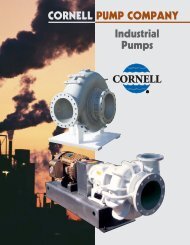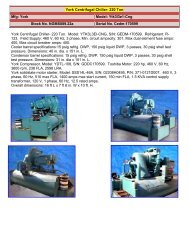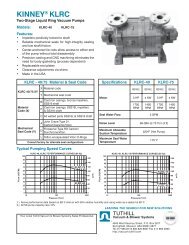2000 APV Tweedy 170 Dough Mixer Mfg: APV Model: 170 Mixer ...
2000 APV Tweedy 170 Dough Mixer Mfg: APV Model: 170 Mixer ...
2000 APV Tweedy 170 Dough Mixer Mfg: APV Model: 170 Mixer ...
Create successful ePaper yourself
Turn your PDF publications into a flip-book with our unique Google optimized e-Paper software.
<strong>2000</strong> <strong>APV</strong> <strong>Tweedy</strong> <strong>170</strong> <strong>Dough</strong> <strong>Mixer</strong><br />
<strong>Mfg</strong>: <strong>APV</strong><br />
<strong>Model</strong>: <strong>170</strong> <strong>Mixer</strong><br />
Stock No: SGMPM086.41 Serial No: 401/1<br />
<strong>2000</strong> <strong>APV</strong> <strong>Tweedy</strong> <strong>Dough</strong> <strong>Mixer</strong> with Inverter Control. <strong>Model</strong>: <strong>170</strong> MIXER. Machine Number: 401/1. Year<br />
/ Contract: <strong>2000</strong> AF990024. <strong>APV</strong> Stainless Control Panel S/N: AF990024. For Bakery applications,<br />
comes with 4 additional interchangeable mixing blade change parts. The <strong>Tweedy</strong> <strong>Mixer</strong> was originally a<br />
development of the Chorleywood Bread Process for a uniform, high-end dough product with user-friendly<br />
controls (Baker Perkins). Mixing Vessel designed for vacuum service, 19.75 in. dia. x 27.5 in. deep<br />
(4.875 Cu. Ft, ~36 gallons). The vacuum mixing option increases bread loaf volume, variable crumb<br />
texture, and structure. Maximum Batches Per Hour: 14. Minimum Batch Size: 85 kg (187 lbs). Maximum<br />
Batch Size: <strong>170</strong> kg (375 lbs). Maximum Output: 2,380 kg/hour (5,247 lbs/hour). Electrical Requirements:<br />
SEW 11 kW (14.7 HP), 1160 RPM, 230/460V, 3-phase (mixer motor). SEW 0.55 kW (0.73 HP),<br />
230/460V, 3-phase (tilt function). 120V 1-phase (controls). Includes Allen Bradley AB PanelView 600<br />
mounted in a stainless steel wash-down control cabinet (panel S/N: AF990024). Pump is manufactured<br />
by The Utile Engineering Co. Ltd, model D26, S/N: M 104418. Allen Bradley Rockwell manuals for<br />
controls, modules, power supplies, VFD units, etc included.<br />
<strong>Dough</strong> Mixing Vessel: Design Pressure: 1.0 Bar Gauge to -1.0 Bar Gauge. Design Temp: 50 Celsius.<br />
Hydraulic Test Pressure: -1.8 Bar Gauge. 19 ¾ in. dia. x 27 ½ in. deep. Date: 5-23-<strong>2000</strong>. Comes with 4<br />
more interchangeable mixing blade setups.<br />
SEW Eurodrive Motor: 11 KW, 1160 RPM, 230 /460 Volt, 41.0 / amps, Brake Volt 440, 60Hz.<br />
Vessel Tilt Function: SEW Eurodrive, Type: 8A77TDT8DN6BMGHR, NO: 30.1100019.01.00.2, ROM<br />
4.9 RATIO 225.26, 230/460 VOLTS, 2.90/1.46 AMPS, BRAKE VOLTS: 240, 3 PH, 60 HZ.<br />
Utile Vacuum Pump: <strong>Model</strong>: D26, Serial: 101053 & 104418, WEG Motor, 1/99, 20v 2.2 KW 50 Hz up to<br />
480 V 2.6 KW 60HZ<br />
<strong>APV</strong> Control Panel with AC cooling unit: Panel Serial # AF990024, Approx f.l.c 52 amps, Drawing #<br />
PD1142, 5-23-200<br />
Supply: 460 Volts 3 Ph 50 c/s<br />
Control Circuit 120 Volts 1 Ph 50 c/s<br />
Details from the manufacturer:<br />
A truly automatic dough mixing system<br />
Pressure/vacuum mixing + inverter control<br />
Bakers around the world are taking increasing advantage of the quality and cost benefits offered by the<br />
pressure/vacuum option available with all Baker Perkins ‘<strong>Tweedy</strong>’ high-energy mixers.<br />
Controlling the speed of the main motor during ingredient dumping and dough discharge, in conjunction<br />
with fully automatic ingredient feeds, makes a truly automatic mixing system possible.<br />
Pressure vacuum mixing is now widely used at industrial bakeries in the UK, Europe, Africa and<br />
Australasia. During the process, pressure and vacuum are applied sequentially to the mixing bowl.<br />
Air is beaten into the dough by pressurising the bowl in the first part of the cycle, providing more oxygen
to enhance the operation of Ascorbic Acid as the oxidising agent. In the second mixing phase, partial<br />
vacuum controls the formation of the bubbles in the dough to refine the crumb structure.<br />
The pressure and vacuum stages of the cycle can be adjusted so that the full range of structures can be<br />
produced, from open-structured breads such as baguettes to pan breads with close and uniform<br />
structures.<br />
Traditional process control characteristics – flour/water weight proportioning, accurate water blending<br />
and energy control – are all retained.<br />
Cost saving and quality enhancing benefits include increased yield as dough is more machineable at a<br />
higher water content; improved crumb colour and softness – and hence improved shelf life; and a<br />
reduction in expensive Ascorbic Acid normally used to aid oxidation.<br />
Inverter control for the main motor permits variation of mixing impact plate speed, creating a high degree<br />
of versatility during mixing. Five different settings in the recipe allow impact plate speed to be varied<br />
during the mix, fine-tuning the energy profile, and avoiding damage to inclusions such as soft fruit.<br />
A further significant advantage is much improved dough discharge, with tilt possible to an angle of 50º<br />
below the horizontal - this increases efficiency and eliminates the need for a full time operator.<br />
(www.bakerperkinsgroup.com/tweedymixers)



